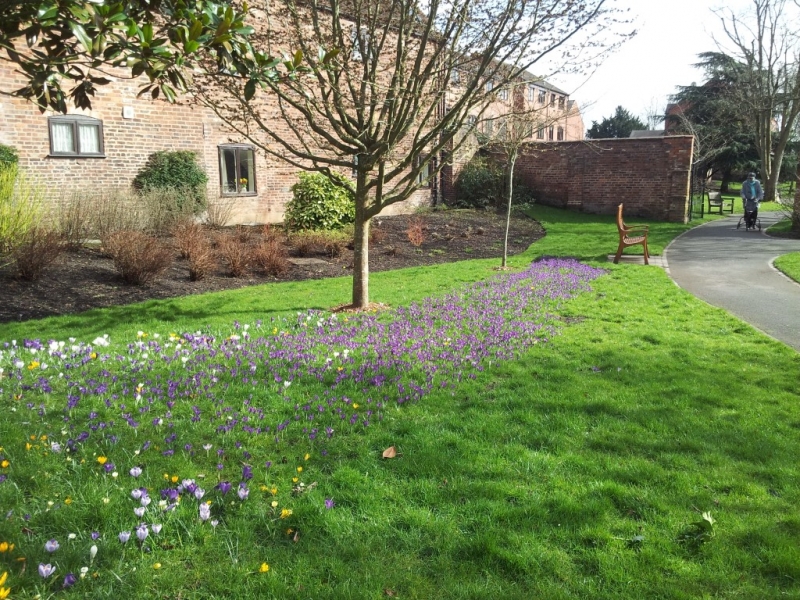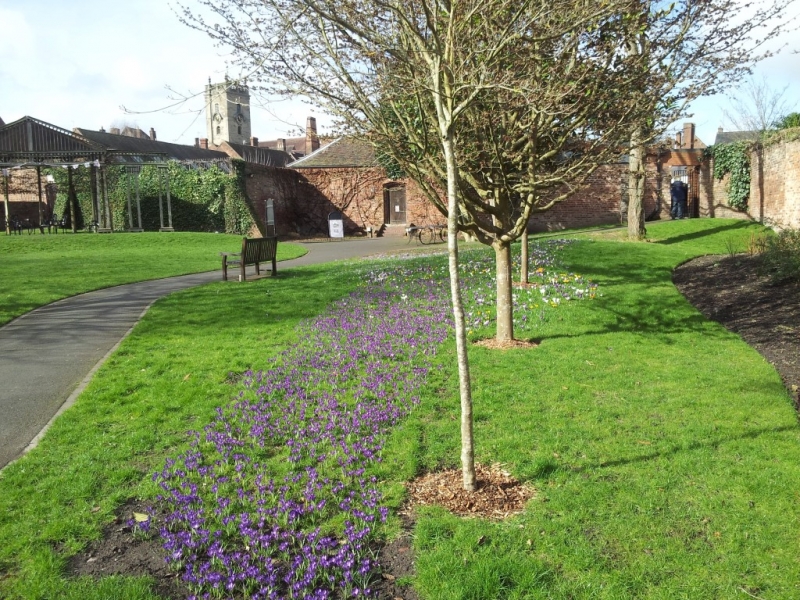Purple 4 Polio in Bloom
We planted the bulbs in October and lots of people are enjoying the blooms in March, but....Why purple crocus? Find out below
Visitors to the Jubilee Gardens will see, near the rear entrance to Bewdley Museum, a swathe of purple crocus and may well appreciate the beauty without realising the significance.
5000 crocus bulbs were planted in October 2016 by members to raise the profile of the Rotary International ‘Polio Plus’ campaign to eliminate polio from the world.
In addition our Rotakids Club at Chaddesley Corbett Primary School planted a similar amount of bulbs near to the front entrance to the school.
Poliomyelitis has caused paralysis and death for much of human history. As a child the Roman Emperor Claudius was believed to have been stricken by polio, causing him to walk with a limp for the rest of his life.
However, it was not until the 1900s that major epidemics began to occur in the developed world, primarily in cities during the summer months. At its peak in the 1940s and 1950s polio paralysed or killed over half a million people worldwide every year.
The first polio vaccine, developed by Jonas Salk, was announced to the world in 1955. Following mass immunisations the number of cases of polio in the USA and Europe were reduced dramatically. Eight years after Salk's success, Albert Sabin developed an oral polio vaccine which was licensed in 1962. There have been no cases of polio in the UK since 1982 and by 1988 polio had disappeared from the US, Australia and much of Europe but remained prevalent in more than 125 countries.
In 1979 Rotary Clubs in the Philippines obtained a financial grant from the Rotary Foundation, Rotary’s own charity, to immunise all the children against the disease, and members of Rotary throughout the islands were mobilised to manage and carry out the task. Some 6 million children were immunised against polio. It was a huge success and as a consequence in l982 Rotary International set in motion a plan to give polio vaccine to all the children in the world. Dr. Albert Sabin, the creator of the oral vaccine, said it would cost at least US$100 million and 500 million children would need to be immunised so Rotary set a goal of US$120 million under a project name of ‘Polio Plus’.
By 1987 Rotary Clubs around the world had raised US$247 million. So, Rotary leaders went to the World Health Organization in Geneva and said “We have over a million volunteers and US$247 million and we want to eradicate polio”. The outcome was that Rotary, The World Health Organization, UNICEF, and The US Centers for Disease Control became partners in the Global Polio Eradication Initiative (GPEI). In 2007 the Bill and Melinda Gates Foundation joined with Rotary and committed to match 2 to 1 the amount raised by Rotary, donating so far in excess of US$500 million.
Since the work of the GPEI commenced over 2.5 billion children have been immunised and the cost had reached US$11 billion. Governments around the world have committed to support the task of eradication with the main contributors being US, UK, Germany, Japan, Norway, Canada and Australia. The UK government’s Department for International Development will have, by the end of 2018, donated £900 million.
The World Health Organisation stated in January that an additional US$1.3 billion is needed through to 2019 to reach more than 400 million children in up to 60 countries and to ensure high quality surveillance.
Polio is endemic in three countries only. Afghanistan, Pakistan and Nigeria. In 2016 there were 34 cases only reported. It is very likely that in 2017 the last case ever of polio will be seen. However, after the last case, another four years will have to elapse before we can be sure it has gone for ever and during this period children will have to receive the vaccine.So what have Purple Crocus have to do with all this? Well, when health workers go into remote areas to administer the vaccine they need to know which children have, or have not, had the vaccine, so after receiving the oral vaccine the child’s finger is dipped into a purple dye, which is what the colour of the crocus represents.
Related pages...
.jpg)
Purple 4 Polio February 2024
more Published in the February 2024 edition of 'The Bewdley Bridge'

Successful District Foundation Grant Application
more The Club have been successful in obtaining a matching District Foundation grant for playground equipment at Cornerstone School in Kititi, Uganda
_1.jpg)
Polio Exhibition Preview Evening
more The open night of the Fight to End Polio Exhibition

Planting 4 Polio
more Bewdley Club Members and our Rotakids Club planted 10,000 crocus bulbs
back to page above this...
The Rotary Foundation
back The Rotary Foundation is Rotary's own Charity
.jpg)

